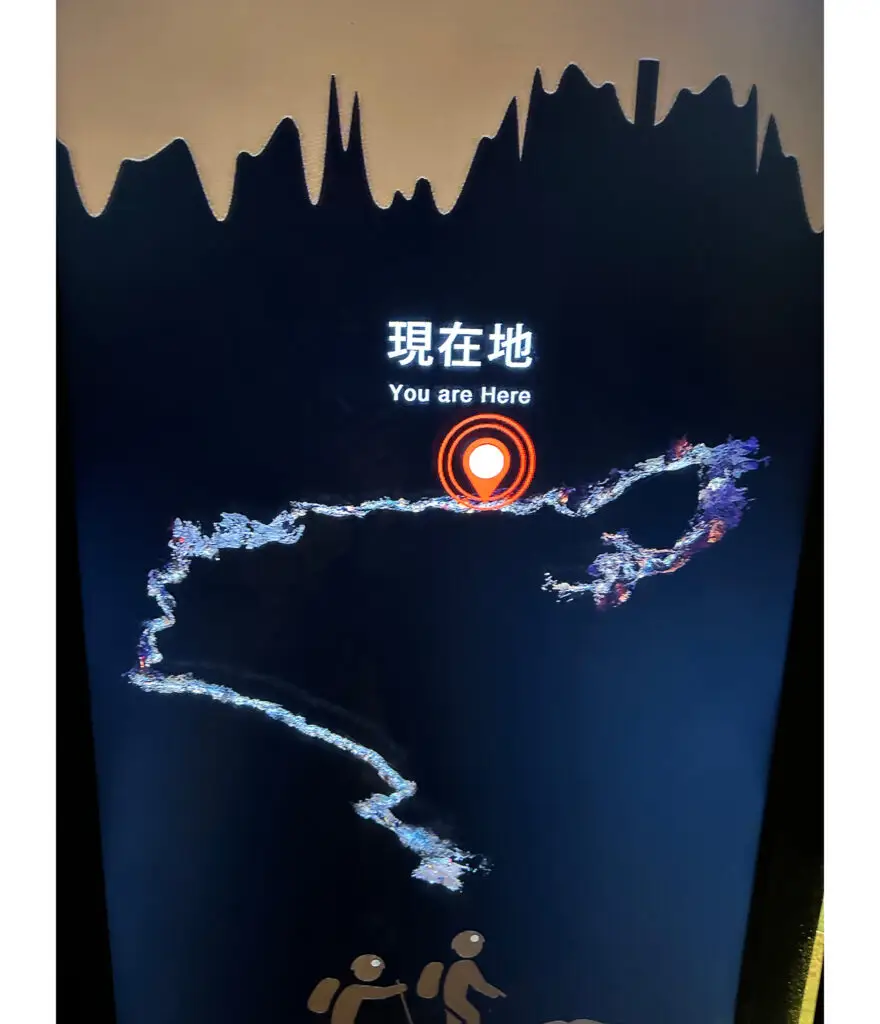Japan has a reputation for beauty and hospitality, therefore, it was at the top of our Bucket List. The distance to get there has always been the problem. To see Japan’s Temples, Shrines and Palaces in a reasonable period, consequently, required a plan.
 Cruise ship travel would offer the best way to see the country, firstly, because of the available guided tours of the cities and sites and, secondly, only having to unpack once. The cooking classes we enjoyed were another bonus on this cruise.
Cruise ship travel would offer the best way to see the country, firstly, because of the available guided tours of the cities and sites and, secondly, only having to unpack once. The cooking classes we enjoyed were another bonus on this cruise.
The Country
Japan is a captivating country where ancient traditions blend seamlessly with modern technology. Japan offers a diverse range of attractions that should appeal to every traveler no matter their interests, firstly, from majestic temples and serene gardens, and secondly, to bustling urban cities and picturesque landscapes.
The country is deceptively large. Japan’s land mass is one and a half times greater than that of the entire United Kingdom. Traveling in Japan, north to south, is the same as from Maine to Florida in the United States. Additionally, self travel in Japan is a challenge because 75% of the country is mountainous.
We include many superlatives about Japan trip in our highlights because the Japanese truly care about their culture and nature. Immaculately groomed and maintained gardens as well as carefully restored and promoted temples and shrines demonstrates Japan’s sincere love and reverence for their history and country. The Japanese are pleasant, respectful and, for the most part, happy people. Japan has no graffiti visible to the tourist anywhere. Japan was a joy to visit.
The following are just the highlights of our 15 days of travel. There is still a lot of Japan left to explore and enjoy, consequently a return trip is a must.
Tokyo
Our Japanese experience begins in Tokyo, the vibrant capital city of Japan. We planned three days of sightseeing in Tokyo before venturing out to the rest of the country. Tokyo offers a unique mix of tradition and innovation. The city is amazingly clean, orderly and safe even though it is the world’s largest metropolis. Everybody is expected to dispose of their litter and trash at home, therefore, there are no trash receptacle on public streets.
Our home base while in Tokyo is the Tokyo Hilton in the Shinjuku Ward.
Asakusa Senso-Ji Temple

The Asakusa Senso-Ji Temple is a place that takes you back in time. It offers a serene escape from Tokyo’s hustle and bustle. The Temple is Tokyo’s oldest and most significant Buddhist temple. It is located in the Asakusa district. Stepping into its grounds feels like being in a different era, because, of its traditional architecture, stunning gates, and peaceful atmosphere.
Kaminarimon Gate

Two imposing statues greet us as we enter the Kaminarimon Gate, which means “Thunder Gate”. The statues are Fujin, the god of wind, and Raijin, the god of lightning. The gate’s vibrant red color and massive paper lantern add to its grandeur and allure. We now are on Nakamise Street. It is a bustling, shopping street lined with small shops and stalls selling traditional snacks, souvenirs, and crafts. This is the perfect place to indulge in some retail therapy and become immersed in the local culture.
Hozomon Gate
The Hozomon Gate is the next gate we pass through. It is also known as the “Treasure House Gate” because it contains many precious artifacts and cultural treasures. The main hall of Senso-Ji Temple, called the Hondo, stands majestically beyond the Hozomon Gate. The Hondo is a sight to behold because of its intricate carvings, colorful paintings, and beautiful statues.

A five story pagoda is adjacent to the Hondo. It is a towering structure that offers panoramic views of Asakusa and the surrounding areas.
Smaller shrines and statues of other deities can be found throughout the temple grounds.
Ginza District
The Ginza district is similar to Times Square in NYC, however, Ginza is renowned as a high-end shopper’s paradise. The Shibuya Crossing is the name of the main intersection of the streets in Ginza. An average of 3,000 pedestrians cross these streets in perfect harmony at any one time. It is really hard to fathom that over 2 million people cross this intersection every day.
Imperial Palace
Completely Surrounded by Moats
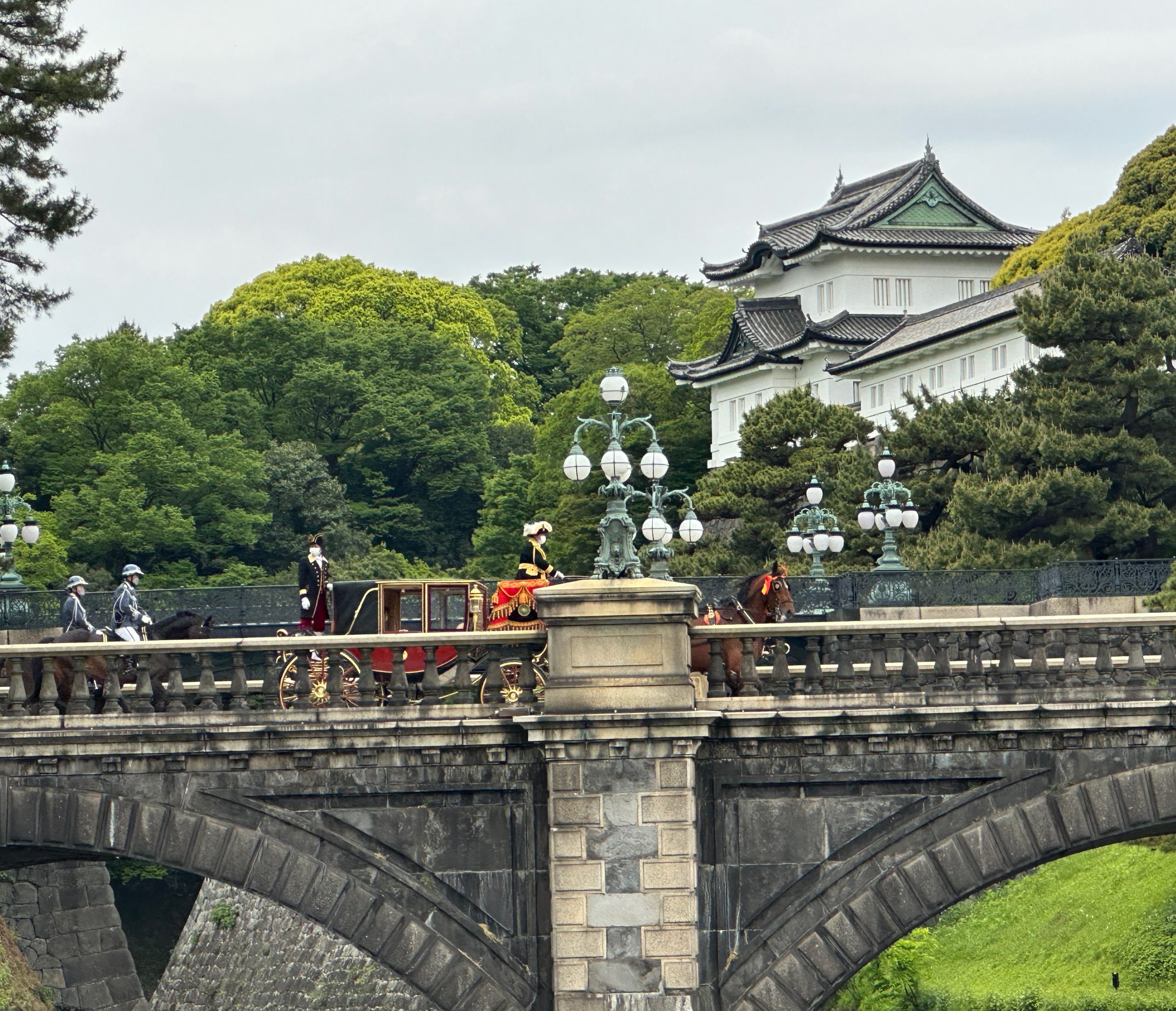
The Imperial Palace holds a special place in Japanese history and culture. It serves as the primary residence of the Emperor Naruhito and his family. Expansive gardens and moats completely surround the Palace. There is a realm of serenity and elegance inside the palace grounds. The City of Tokyo completely surrounds the palace grounds, including the gardens and moats. It seems far removed from the city’s high energy.
The Kyūden
The Kyūden is the centerpiece of the Imperial Palace. Consequently, this is the main palace building where the Emperor conducts official ceremonies and events. Although the palace itself is not open to the public, we still were able to admire its magnificent architecture from the surrounding gardens. The Kyūden showcases a blend of traditional Japanese design and contemporary elements, symbolizing the harmonious coexistence of past and present.
East Gardens
The beautiful East Gardens are one of the highlights of the Imperial Palace. These meticulously landscaped gardens offer a peaceful sanctuary with lush greenery, tranquil ponds, and picturesque bridges.
Stunning stone walls and elegant tea houses are visible from well-manicured paths of the Ninomaru Gardens. Traditional tea ceremonies are held here.
The gardens also provide a glimpse into the palace’s rich history, such as, the ruins of the old Edo Castle found within the gardens. These remnants serve as a reminder of Tokyo’s feudal past and, therefore, add a sense of historical depth to the serene surroundings.
Surprise!

The Prime Minister of Australia and his wife were leaving the palace in a royal horse drawn carriage while we were snapping photos. They came across the Seimon Ishibashi bridge towards us, subsequently stopping to wave. It was a surreal scene.
Hamarikyu Gardens

The Hamarikyu Gardens are a metropolitan garden in Chūō ward of Tokyo. It is a landscaped garden that includes a tidal pond named Shioiri-no-ike. At the centre of Shioiri-no-ike is a teahouse, reached by two bridges. A spreading 300 year old pine tree is nearby the entrance.
National Museum of Nature and Science

The National Museum of Nature and Science is in the northeast corner of Ueno Park in Tokyo. The museum has many historical exhibitions, for example, one on pre-Meiji (before 1868) science in Japan. It is here where we saw the taxidermied bodies of the legendary Antarctic sled dogs Hachikō and Taro and Jiro. In addition, there is a life-size model of a blue whale and an antique Japanese steam locomotive on display outside the museum.
Meiji Jingu Shrine

In our opinion, the south entrance is the best entrance to the Meiji Jingu Shrine. Most importantly, more than 200 traditional sake barrels are there as you enter. They have been collected and donated to the shrine by famous sake breweries.
Wine barrels imported from France are displayed on the other side of the path. Obviously this must have been due to emperor’s love for wine. A huge wooden Torii gate around the corner from the barrels greets us as the official entrance. The Meiji Jingu Shrine is one of Japan’s most famous and important Shinto shrines. Shintoism is unique to Japan. Meiji Jingu Shrine is nestled in the very heart of Tokyo. It covers a vast area including a beautiful, serene forest surrounding the approach to the main shrine.
Shimizu
The City of Shimizu is located on the eastern coast of the Izu Peninsula overlooking Suruga Bay. Shimizu offers beautiful natural landscapes with mountains on one side and the Pacific Ocean on the other. It is about 105 miles southwest of Tokyo.
Miho Shrine
The Miho Shrine is our first stop in Shimizu. It is known for tranquil ambiance and breathtaking views. The shrine dates back to the 7th century. Therefore, it holds great significance in Japanese folklore. Another majestic Torii gate greets us at the entrance to the shrine grounds.
The stone paved path to the shrine is a leisurely walk with towering cedar trees on either side. This path to the main shrine hall has witnessed centuries of prayers and rituals. Intricate wood carvings and vibrant Shinto decorations adorn the Hall.
Miho No Maysubara
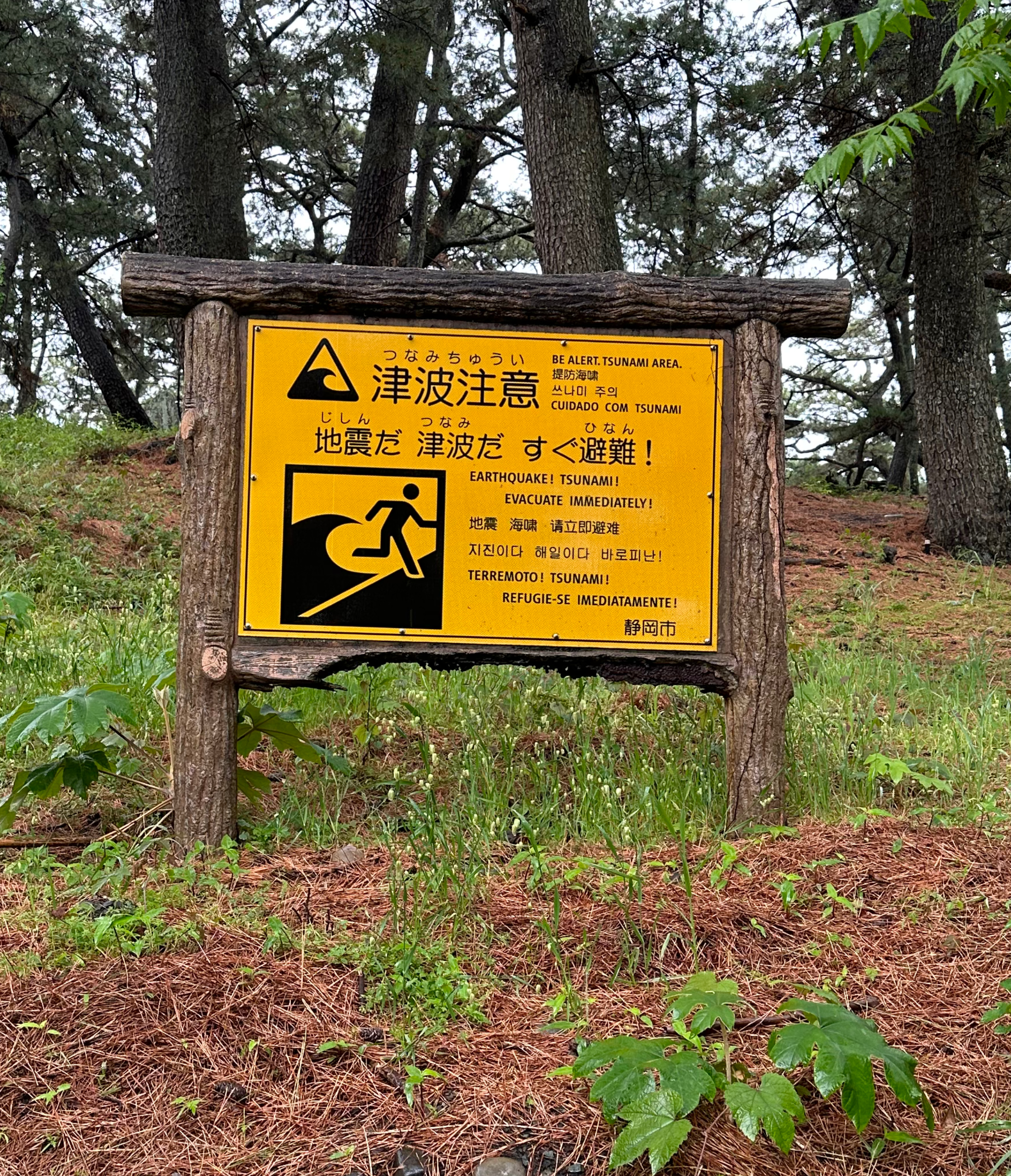
Miho No Matsubara, a captivating coastline, is next to visit. It is just a short walking distance from the Miho Shrine. This picturesque area is renowned for its breathtaking views of Mount Fuji, which normally looms majestically in the distance. Unfortunately for us, this day was rainy, with a cloud cover obscuring the views of Mt. Fuji. The only picture I could take, therefore, was one of a poster at the head of the trail showing My Fuji.
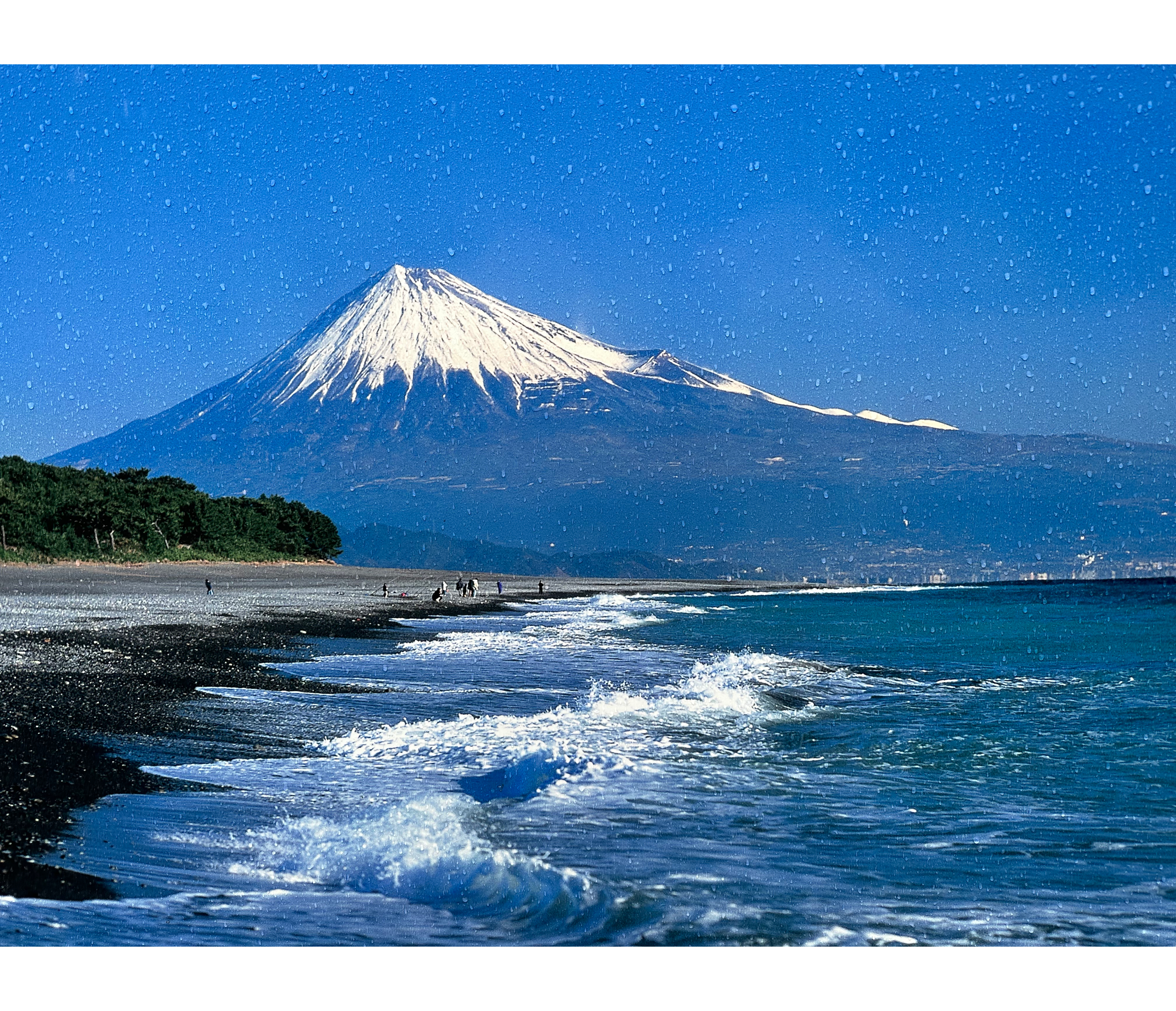
The sound of the waves, the rustling pine trees and the salty breeze did invigorate our non visual senses. We did marvel at the iconic pine trees, with their twisted branches, standing resilient against the harsh coastal winds. This mesmerizing sight has been enjoyed for generations.
Kunozan Toshogu Shrine
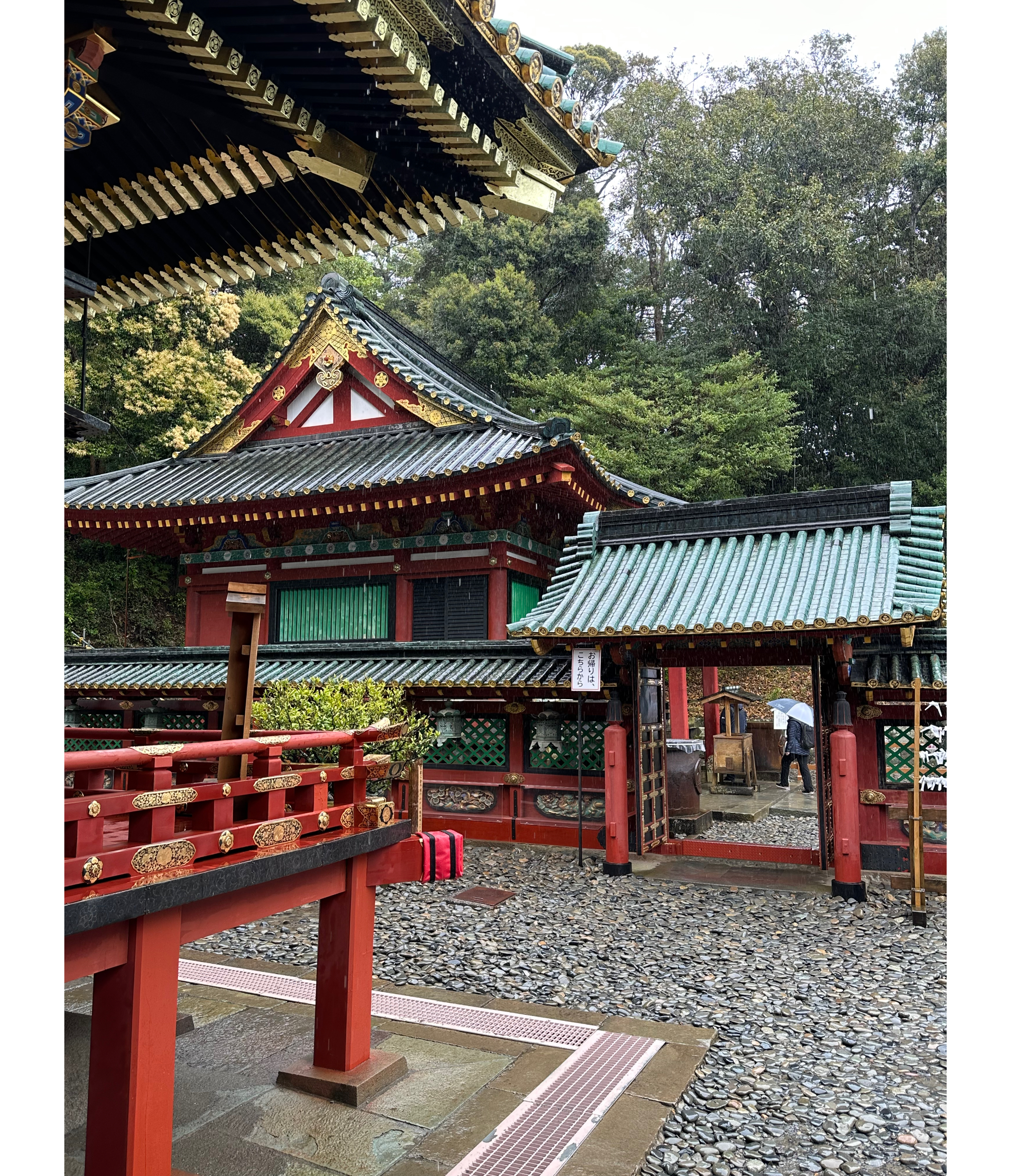
The Kunozan Toshogu Shrine on Mount Kuno was our last stop while docked in the port of Shimizu. We received options of access. We could either hike-in or take a bus to the cable car transit to the Shrine. Of course, we opted for the bus and cable car option. The views from the cable car, called a “rope-line” were incredible. The lush greenery, serene atmosphere, and panoramic vistas makes it worth the trip. What they failed to tell us, however, was the hundreds of steps still remaining to get to the shrine.

Tokugawa Ieyasu must have wanted his followers to suffer while trying to reach his shrine. Not only are there many steps but they were not of a normal height. The risers were quite a bit higher making it difficult, but a great cardio workout.
Kunozan Toshogu Shrine holds a special place in Japanese history. We were told it was built to honor the memory of Tokugawa Ieyasu. He was the founder, and first shogun, of the Tokugawa Shogunate. The shrine was constructed in 1617. and an important pilgrimage destination for loyal followers seeking his blessings and protection.
Kansi Region of Japan
Our ship next docked in Osaka Harbor for our visits to Kyoto and Osaka. Osaka and Kyoto are both located in the Kansai region of Japan, which is in the western part of the country.
Osaka is located on the southern coast of Honshu, the main island of Japan. The City, on Osaka Bay, is approximately 200 miles southwest of Tokyo. Modern architecture, vibrant nightlife, and delicious street food is what Osaka is all about.
Kyoto is located 26 miles to the northeast of Osaka. It is surrounded by mountains. Kyoto is famous for its rich history, traditional temples, and beautiful gardens. The City is known for preserving traditional Japanese culture, in part, because it was capital of Japan for over a thousand years.
Both cities are popular destinations for tourists visiting Japan, because they are very accessible by train and air.
Kyoto
Kyoto is home to numerous UNESCO World Heritage sites, offering a glimpse into the country’s ancient past.
Kinkaku-ji

Our first stop takes us to Kinkaku-ji. This is the Golden Pavilion, an iconic Zen Buddhist Temple. The sight of its shimmering golden exterior reflected in a tranquil pond has us lost for words. Kinkaku-ji, built in the 14th century, is an incredible masterpiece. Meticulously manicured gardens surround the temple.
Sanjusangendo Temple
We arrive next at the Sanjusangendo Temple. This temple is unlike any other of the temple in Japan. 1,001 life-sized statues of the Buddhist deity Kannon are in the main temple hall. Intricately carved in wood and adorned with gold leaf these statues are a truly mesmerizing spectacle. The temple is odd because of the shear number of near identical statues all precisely aligned.
Motorikyu Nijo Castle

The Nijo Castle is our final destination while in Kyoto. It is a UNESCO World Heritage site, most importantly, due its architectural splendor and historical significance. This impressive castle dates back to the 17th century. It served as the residence of the Tokugawa shoguns. Tokugawa Ieyasu also has his shrine back in Shimizu that we highlighted earlier. Nijo Castle offers a fascinating glimpse into the life of Japan’s feudal rulers.
Osaka
Osaka, Japan’s third-largest city, is a vibrant and bustling metropolis renowned for its culinary delights and vibrant nightlife.
Shitennoji Temple
Our first stop is at the historic Shitennoji Temple, one of the oldest Buddhist temples in Japan. Located in the heart of Osaka, this temple dates back to 593 AD and, consequently, holds significant cultural importance. As we approach the entrance gate we start to see more beautiful gardens surrounding the temple.
Garden design and landscaping careers must be very lucrative because there are so many highly maintained gardens in every city.

A stunning five-story pagoda standing tall against the skyline greets us as we enter the temple grounds. The pagoda, a symbol of Buddhist architecture, showcases exquisite craftsmanship and intricate details. Exploring further, we discover the main hall, which houses remarkable Buddhist artifacts and statues. The serene ambiance invites us to reflect and find inner peace.
We also walked through the Gokuraku-jodo Garden. Its wonderfully landscaped ponds, bridges, and lush greenery create a very serene environment.
Osaka Castle

We continue our journey to Osaka Castle, leaving behind the peaceful serenity of Shitennoji Temple. Osaka Castle has been a symbol of power and resilience throughout Japanese history. Towering walls and a majestic moat greet us as we approach the castle grounds.

Osaka Castle was built in the 16th century. The castle stands as a proud testament to the power and influence of the samurai era. We are treated to panoramic views of Osaka cityscape from the castle’s main tower. The city is a blend of modern skyscrapers and traditional roofs.
Inside the castle, we explore its informative museum, which showcases artifacts, armor, and historical exhibits, providing a glimpse into Japan’s rich heritage. The museum beautifully tells the story of the castle’s construction and various historical events that took place within its walls.
Kochi
Kochi City, on the Island of Shikoku, is our next port of call. It is approximately 500 miles southwest of Tokyo. We are visiting Kochi City first, primarily to tour the Kochi Park Castle. After visiting Kochi City we will then travel to Tami to explore the Ryugado Caves.
Kochi Park Castle

Kochi Park Castle, also known as Kochi-jo, is one of the few original castles remaining in Japan. The castle complex’s main building houses a museum. Here, samurai armor, weapons, and other historical artifacts are displayed. Kochi-jo is almost entirely constructed of wood, including the walls, floors, and roof. In Japan many historical structures have experienced destruction by fire, either intentional or by accident. Kochi Castle has also undergone several fire related renovations and repairs over the years.
Ryugado Caves
Ryugado Caves are limestone caves located near Kochi City. These caves are known for their impressive stalactite formations and underground river system. Exploring the caves is like stepping into a hidden world with unique geological features. We navigated through the caves on a guided tour, learning about their natural history.
Hiroshima
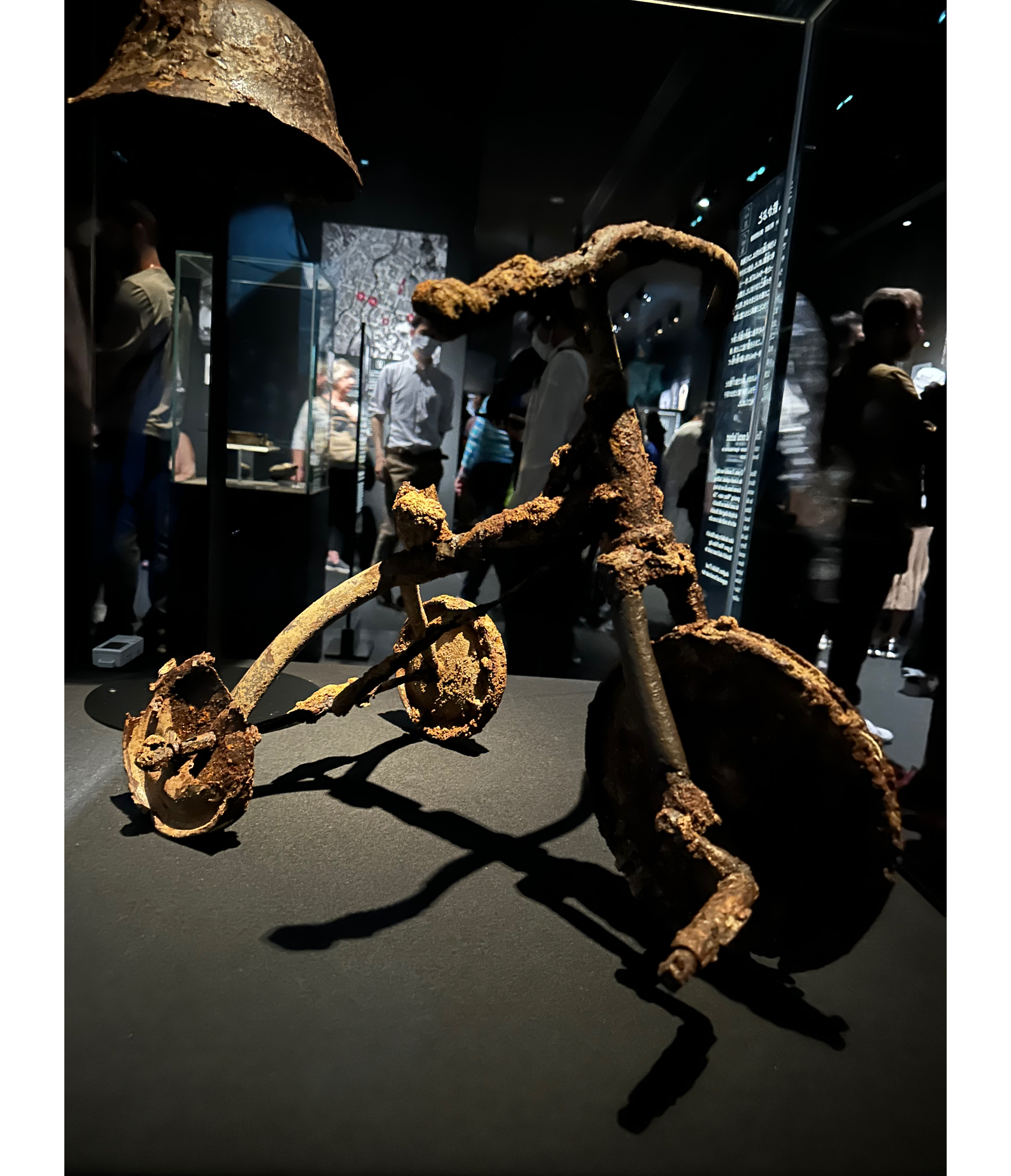
Hiroshima is a city located in southwestern Japan, more specifically, in the western part of the Honshu island, along the coast of the Seto Inland Sea. The City is approximately 435 miles west of Tokyo and 211 miles southwest of Osaka. The city was one of only two cities to ever experience the horrific effects of an atomic bomb detonation.
Today, Hiroshima is a vibrant and resilient city that showcases a remarkable blend of historical significance and natural beauty.
Atomic Dome Hiroshima

Our first stop is the iconic Atomic Dome, also known as the Hiroshima Peace Memorial. This UNESCO World Heritage Site is in the Hiroshima Peace Memorial Park. It stands as a somber reminder of the destructive power of nuclear weapons. The dome is a skeletal structure that was once the Hiroshima Prefectural Industrial Promotion Hall. On August 6, 1945 an atomic bomb was detonated and severely damaged this building along with most of the city. The building serves as a symbol of resilience and peace by urging visitors to reflect on the horrors of war and promote global harmony.
Hiroshima Memorial Peace Park

The Memorial Peace Park is adjacent to the Atomic Dome. It is a tranquil and beautifully landscaped area dedicated to promoting peace and honoring the victims of the atomic bombing. As we walked through the park, we came across numerous statues, monuments, and memorials that pay tribute to the lives lost and the importance of peace. One of the most notable structures is the Children’s Peace Monument. Sadako Sasaki inspired this monument. She was a young girl who folded paper cranes in hope of healing the city after the bombing. It serves as a poignant reminder of the countless innocent lives impacted by war.
Shukkeien

Stepping away from the historical sites, we then visited Shukkeien. It is a traditional Japanese garden located in the heart of Hiroshima. Shukkeien, which translates to “shrunken-scenery garden,” offers a serene escape from the bustling city. Walking through the meticulously designed pathways, we encountered various landscapes, including miniature mountains, ponds, tea houses, and meticulously pruned trees. The garden’s tranquil ambiance provides a perfect opportunity to unwind, contemplate, and appreciate the beauty of nature.

Nagasaki

Nagasaki is a city located on the western coast of Kyushu, the southernmost of Japan’s four main islands. The city is situated with the Nagasaki Bay to the south and the mountains to the north, making it a picturesque coastal city.
The Peace Park
Located in the central part of Nagasaki, the Peace Park encompasses several important memorials and monuments that honor the victims and promotes peace and understanding. Before we explored the park, we visited the Nagasaki Atomic Bomb Museum nearby. It provided us with a comprehensive overview of the events leading up to the bombing and its aftermath.
As we entered the Nagasaki Peace Park, we first notice the iconic symbol of peace, the Nagasaki Peace Statue. This impressive designed by sculptor Seibo Kitamura depicts a man with one arm outstretched. It symbolizes both the threat of nuclear weapons and the desire for peace.
The park features several other notable monuments, including the Fountain of Peace, which uses water to represent the hope for a peaceful world. Nearby is a Peace Bell, which visitors can ring to pray for world peace. The sound of the bell resonating through the park creates a solemn and peaceful atmosphere.
Memorial Zone
The Memorial Zone is one of the most poignant areas within the Peace Park. Here, you’ll find the Peace Park Memorial Cenotaph. The Cenotaph stores the names of the victims of the atomic bombing. It serves as a symbolic link, aligned between the Peace Statue and the point of the hypocenter.

In addition to the monuments and memorials, the Nagasaki Peace Park offers beautiful gardens and green spaces for visitors to relax and reflect.
Country of Contrast
Japan is both very new and very old. There are castles, palaces and modern skyscrapers in Japan. Tokyo has rickshaws and bullet trains. The Japanese honor their history and welcome their future. The country embraces all religions, firstly, Buddhism and secondly, Shintoism. Shinto focuses on the worship of nature, ancestors, and spirits called kami. Buddhism, on the other hand, is a more traditional religion based on the teachings of Siddhartha Gautama (Buddha). The country is small is size when compared to many other countries, but it is an economic powerhouse. Its economy is the third largest in the world.







